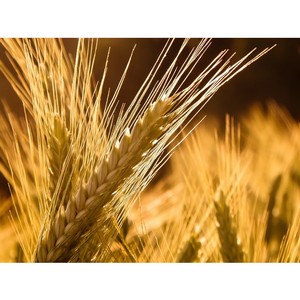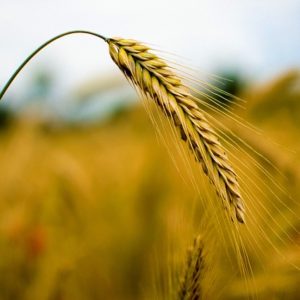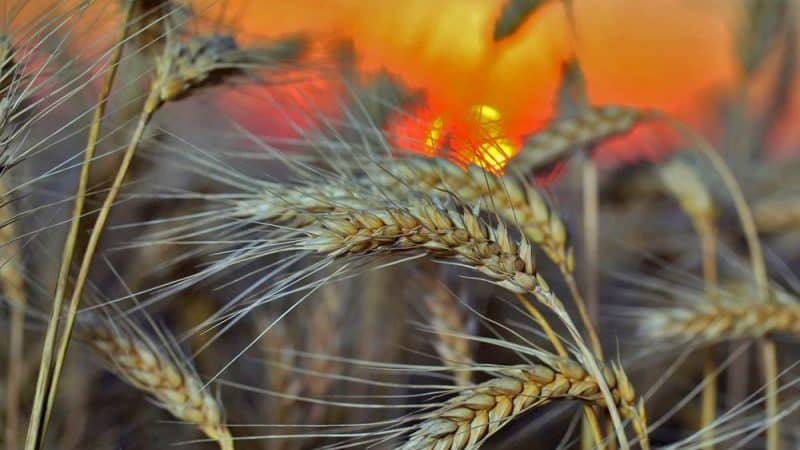What varieties of rye are there: seed, winter and other varieties
Rye is resistant to harsh climates and has many beneficial properties - thanks to these qualities, it is cultivated throughout Russia. We’ll tell you in the article what types of rye there are, what qualities it has and where it’s used.
Description and characteristics of rye
This is a genus of herbaceous plants from the family Poaceae (Potaceae), belongs to the order Wheataceae, along with barley, wheat, mortuca, wheatgrass and corn grass.
The root system is fibrous, grows to a depth of 2 m. Rye is able to grow on infertile sandy soils due to the ability to be naturally fed with complexly soluble compounds. Bushy stems grow into either 4 or 90 shoots, which are knotty cylindrical straws.
Interesting! Rye can reach 2.5 m in height, but on average this figure ranges from 70-100 cm.
The leaves are green, rough with a slight waxy coating and lanceolate in shape. The stem ends in a spindle-shaped spike, consisting of segments - small spikelets: dense, medium-dense or loose.
Reference. The ears of cultivated rye are durable and elastic, while those of wild rye are fragile and brittle. Each segment contains one oval-shaped seed, the length of which is 5-10 mm and the width is 1.5-3.5. Rye grains are white, green, purple, brown or yellow.
Chemical composition, trace elements, vitamins
Per 100 g of grains there are:

- proteins – 9.9;
- fats – 2.2;
- carbohydrates – 55.8;
- calorie content – 283 kcal.
The grains contain microelements: Mg, Ca, S, Cl, Zn, Fe.
Vitamins included: B7, E, B3, B5, B1, B6, B2, K, P.
Acid balance (pH) 4.3-5.5.
Beneficial features
Rye contains a lot of nutrients, but in past centuries it was considered a rough food for peasants and common people. Thanks to this cereal, poor people in Rus' survived during long and harsh winters.
Rye also has medicinal properties:
- has a beneficial effect on the cardiovascular system;
- strengthens the immune system;
- normalizes the functioning of the nervous system;
- affects the condition of the skin, hair and nails;
- improves blood circulation;
- normalizes the functioning of the gastrointestinal tract;
- reduces blood glucose levels.
For the healthy gastrointestinal tract of a healthy person, this cereal does not pose any danger and is perfectly digestible. It promotes weight loss by normalizing intestinal microflora, alkalizing the body and restoring normal metabolism.
Rye is added to the diet by diabetics, since its glycemic index is low: in sprouts - 34 units, in flour with bran - 32 units, in whole grains - 40 units.
Harm
Rye contains gluten, so it should not be consumed by people with celiac disease. For them, this substance is contraindicated, as well as for patients with gastrointestinal disorders - ulcers and gastritis with increased stomach acidity.
Areas of application of rye
Rye is used in cooking, medicine and agriculture. For Russian peasants, this was not only a hearty and inexpensive lunch, but also a means of getting rid of evil spirits. Bunches of ears of corn were placed in the cradle of newborn children to protect them from any harm.
On the farm, rye is used for different purposes:
- The cereal improves soil quality and is actively used as green manure.This natural green fertilizer can make alumina more loose and suitable for sowing other crops.

- Many peoples have long noted the strength of rye straw rods and began to use them for laying roofs. They turn out to be quite durable and can last for decades. Adobe bricks also contain rye straw and are often used in the construction of eco-villages.
- This cereal is a favorite treat for livestock: food with the addition of rye is especially nutritious. Straw is used to make comfortable bedding that retains heat in cold weather.
- Rye is used to mulch strawberries and as fertilizer for mycelium.
Adherents of a healthy lifestyle and nutritionists suggest replacing white wheat bread with rye bread, because it is healthier and helps normalize metabolism.
Important! For healthy bread, the dough is kneaded with whey or sourdough grown from the flour itself.
If you flavor rye bread with caraway seeds or coriander, the acid will not be so noticeable. To make it more bland, you can add a little oatmeal, flaxseed, wheat or barley flour - preferably whole grain. Sunflower, flax or pumpkin seeds will be a healthy and tasty addition. Breads, buns, pies, cheesecakes, muffins and gingerbreads, flatbreads with the addition of whole grain flour are baked from rye.
The most delicious kvass is made from rye crackers. It is refreshing and has a slight hop effect.
For those who want to lose weight, jelly made from rye grains with the addition of barley, oats and wheat is suitable: all ingredients are ground in a coffee grinder, poured with chilled water and cooked until thickened over low heat. A few flax seeds will make the drink more jelly-like.
Porridge made from rye grains is a dish for true gourmets or fans of a healthy lifestyle, but when combined with wheat it becomes an energetic and low-calorie breakfast dish for everyone.
Rye used in folk medicine and helps with various diseases:
- Sprouted rye and rye bread have a mild laxative effect and are good for constipation, and a decoction of the grains strengthens and is used to treat diarrhea. It is also used as part of complex therapy for bronchial asthma and diseases of the respiratory system.
- Rye bread softened in water is a remedy for treating skin diseases. Women use face masks to make their skin firm and smooth.
- Rusks made from black bread help the body recover from severe poisoning, complex operations, and respiratory diseases, if there are no contraindications.
- Baked goods made from rye flour strengthen muscle tissue, give the body energy and increase performance.
- Rye alleviates the condition of arthritis, atherosclerosis, anemia, hypertension, arthrosis, kidney and liver diseases.
- A decoction of rye grains helps with a painful dry cough. It has an expectorant effect, and when added with ghee, it will have a gentle effect on the inflamed tissues of the throat.
- Rye tincture with vodka is prepared with the addition of honey and barberry root. It reduces joint pain.
- Sprouted rye, boiled in milk in the form of porridge, is good for the cardiovascular system.
- A sour decoction of rye is used to treat nicotine addiction - its taste discourages the desire to smoke.
What types and varieties of rye exist?
According to the international Internet project “The Plant List,” which contains information about the plant kingdom, rye has 8 species, including wild and cultivated:
- Secale africanum – African;
- Secale anatolicum – Anatolian;
- Secale derzhavinii – Derzhavin’s rye;
- Secale montanum – mountain;
- Secale sylvestre – wild (forest);
- Secale vavilovii – Babylonian rye;
- Secale segetale – rye;
- Secale cereale – cultivated.
In nature, this plant is perennial, but domesticated species live for a year or two. Cultivated (sown) rye can be: winter, annual, biennial, spring. About 50 varieties of rye are actively cultivated in Russia.
Winter rye varieties:
- Alpha. The variety is resistant to mold, rust and lodging. It endures winter with firmness. Grains are added to products made from other varieties of rye to improve their taste.
- Tatarstan relay race. The variety belongs to the mid-late variety. Up to 125 cm in height. The stems are strong and resistant to lodging. The Tatarstan relay does not suffer from powdery mildew, white mold and rust, which allows it to grow successfully in humid climates. The grains are large, rich in amino acids. Flour from the Tatarstan Relay is used for the baking industry and the preparation of dietary foods.
- Tatarskaya 1.A mid-late variety, reaching a height of 115 cm. Tatarskaya 1 is frost-resistant and rarely suffers from snow mold and root rot. The main disadvantage is vulnerability to powdery mildew and brown rust. This does not allow the cultivation of the rye variety in regions where these diseases are widespread. Tatarian 1 can be grown on infertile soils and is best sown as an insurance variety.
- Bezenchukskaya yellow grain. It grows mainly in the Orenburg region, Kazakhstan, the Volga region and Bashkiria. The variety is winter-hardy and not afraid of drought. Ideal for difficult steppe conditions. The ears are dense, medium in size, with small yellow grains.
- Saratovskaya 7. This is a mid-season variety.Frost-resistant and drought-resistant, not subject to lodging. All ears are of the same height with large grains. It has excellent baking characteristics and belongs to class 1. The variety is not susceptible to brown rust, powdery mildew and snow mold. Will be born well in the regions of the Middle and Lower Volga region.
- Slavia. The plant is semi-erect with increased frost resistance. The variety is recommended for cultivation in the Leningrad region. The average yield in this region is 32.5 c/ha. Standard drought resistance. Susceptible to snow mold.

Rye varieties with a recessive gene:
- Type with dominant short stem discovered in rye from Bulgaria (K-10028) in the naturally mutated EM-1 gene isolated by Professor Kobylinsky. Introduction of the gene into a rye variety shortens the length of the straws by 25%. In the homozygous state for the hl hl allele, short stature disappears and the stems grow well.
- Pleiotropic type of recessive short stemness is in the genome of Moscow dwarf rye and Vyatka Moscow. The main role is played by the ct (compactum) gene allele. Not only the stem is shortened, but also the leaves, awns, anthers and grains.
- Monotropic recessive gene representatives of foreign selection have a short stem: Danae, Petkusser Kurstrog, Kungsreg II, Stalreg, Dominant.
Popular varieties in Russia:
- Vyatka. This variety is more common than others in our northern latitudes, the central district and the east of the country. It grows in Kazakhstan and Belarus. Vyatka is resistant to low and high temperatures, produces high yields and successfully resists pests. The ears are of medium length, gray-green grains are born large and have an oval shape. This variety has two subspecies: Vyatka Moscow and Vyatka-2.
- Valdai. The variety is intense and early ripening. Gives a stable, rich harvest of large grains with excellent technical qualities. Valdai is frost-resistant, not susceptible to snow mold and brown rust, and resistant to lodging. Most baked goods are baked from this type of rye.
Read also:
What kind of cereal is made from rye and its beneficial properties.
Conclusion
The nutritional and beneficial properties of rye have firmly strengthened its position in the daily diet of people. Eating rye bread and cereals with the addition of rye provides the body with vitamins and alleviates the condition of many diseases. Rye is used in medicinal and dietary nutrition, and for cosmetic purposes.